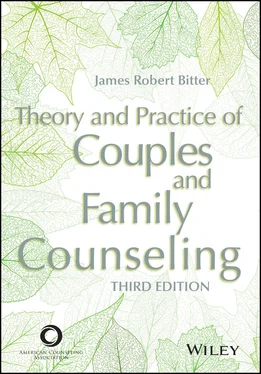James Robert Bitter - Theory and Practice of Couples and Family Counseling
Здесь есть возможность читать онлайн «James Robert Bitter - Theory and Practice of Couples and Family Counseling» — ознакомительный отрывок электронной книги совершенно бесплатно, а после прочтения отрывка купить полную версию. В некоторых случаях можно слушать аудио, скачать через торрент в формате fb2 и присутствует краткое содержание. Жанр: unrecognised, на английском языке. Описание произведения, (предисловие) а так же отзывы посетителей доступны на портале библиотеки ЛибКат.
- Название:Theory and Practice of Couples and Family Counseling
- Автор:
- Жанр:
- Год:неизвестен
- ISBN:нет данных
- Рейтинг книги:5 / 5. Голосов: 1
-
Избранное:Добавить в избранное
- Отзывы:
-
Ваша оценка:
- 100
- 1
- 2
- 3
- 4
- 5
Theory and Practice of Couples and Family Counseling: краткое содержание, описание и аннотация
Предлагаем к чтению аннотацию, описание, краткое содержание или предисловие (зависит от того, что написал сам автор книги «Theory and Practice of Couples and Family Counseling»). Если вы не нашли необходимую информацию о книге — напишите в комментариях, мы постараемся отыскать её.
Theory and Practice of Couples and Family Counseling — читать онлайн ознакомительный отрывок
Ниже представлен текст книги, разбитый по страницам. Система сохранения места последней прочитанной страницы, позволяет с удобством читать онлайн бесплатно книгу «Theory and Practice of Couples and Family Counseling», без необходимости каждый раз заново искать на чём Вы остановились. Поставьте закладку, и сможете в любой момент перейти на страницу, на которой закончили чтение.
Интервал:
Закладка:
More than 50% of all first marriages last a lifetime. (Adapted from Walsh, 2016a)
Early family counseling models focused primarily on family dysfunction, especially models in which the therapist assumed the position of being skilled at resolving family difficulties. In the past two decades, the emphasis in family counseling has shifted to a focus on family strengths and to the family’s capacity for resilience , or the ability to recover, heal, and grow after facing adversity or personal and often family challenges. Any personal or relational crisis is initially experienced as a shock. Some of these shocks are basically short-term problems with which the individual, couple, or family must cope. When a complex shock hits the couple or family system, it signals a need for change and often sends the system into chaos. In many families, it is not one stressor that does the system in but rather the cumulative effect of many stressors over a long period of time. This latter condition almost always forces the couple or family to redefine who they are. Still, in the face of significant stressors, it is amazing how many couples and families rise from what seem like ashes. They seldom do this alone: They often have help and support from extended family, from friends, from religious and spiritual communities, and from social agencies. Counselors who bring a strengths-based framework to family counseling often start by noting the strengths the family has already demonstrated under stress; they assume that no single approach to healthy functioning fits all families; they interview the couple or family as experts in finding their own solutions; and they focus on optimism, courage, possibilities, flexibility, connectedness, and internal as well as external resources. Resiliency-focused counselors support clear communication, the expression of personal truths and shared pain, the use of empathic responding, and an appreciation of diversity. Those who place an emphasis on problem-solving seek to engage the family in brainstorming, resource hunting, shared decision-making, negotiations, fairness, collaborative planning and implementation, and above all else a positive stance.
Differences Between Systemic and Individual Approaches
There are some significant differences between systemic approaches and those associated with individual counseling. To be sure, there are some similarities too, but it is the differences that set the orientation of the helper toward those who are served.
Individual counseling tends to focus on the development of the individual’s self, coping responses, and problem-solving. People are seen in isolation from the systems in which they live, and the counselor is betting that the 1 hour of influence they have each week will be greater than the influences in the rest of the client’s life. In individual counseling, clients are assessed against fixed norms, and their symptoms are considered in relation to standard descriptions of psychopathology. In many therapeutic models, the counselor is still expected to be objective, to discover the cause of painful emotions or disruptive behavior, and, having found the cause, to do something to fix it. It is not uncommon in these same approaches for close attention to be paid to the content of what people say, and constant judgments must be made about the functionality or improvement of the client.
Modern systems practitioners tend to want as many members of the family as possible in the room—often including friends and other members from the family’s community. It is not, however, how many people are in the room that counts: it is how the family practitioner thinks about the people in the room. It is about focusing on transactions, sequences of interaction, interdependence, recursion, and mutual influence (concepts more fully defined in subsequent chapters): It is about process. It involves seeing the purpose and systemic logic in what often appear to be paradoxical processes. It is accepting the subjectivity of the family practitioner, studying it, knowing it, watching for its impact on the counseling session, and working to place it in the service of clients’ well-being. It is learning to see how a problem affects the couple or family and how these systems maintain the problem. It is understanding that each individual has an internal system (Schwartz, 2001), and it is learning to consider the impact of larger systems on the family, especially the politics that relate to race, gender, culture, sexual or affectional orientation, age, socioeconomic status, and creed. And most recently, it also includes listening to the stories within families, and the stories about these stories, and the ways in which each person participates in creating their own realities as well as the stories about these realities.
In short, family practitioners seek to address systems embedded in systems that are embedded still further in other systems. They seek to explore the meaning and purpose of interactions and transactions and engage in processes that support the kinds of solutions that individuals and families seek for their own lives. In Theory and Practice of Counseling and Psychotherapy (Corey, 2017), Gerald Corey and I used the case of Ann to illustrate the differences between what an individual practitioner and a systemic practitioner might do:
Ann, age 22, sees a counselor because she is suffering from a depression that has lasted for more than 2 years and has impaired her ability to maintain friendships and work productively. She wants to feel better, but she is pessimistic about her chances.
… Both the individual [counselors] and the systemic [counselors] are interested in Ann’s current living situation and life experiences. Both discover that she is still living at home with her parents, who are in their 60s. They note that she has a very successful older sister, who is a prominent lawyer in the small town in which the two live. The therapists are impressed by Ann’s loss of friends who have married and left town over the years while she stayed behind, often lonely and isolated. Finally, both therapists note that Ann’s depression affects others as well as herself. It is here, however, that the similarities tend to end:
The individual [counselor] may:The systemic [counselor] may:Focus on obtaining an accurate diagnosis, perhaps using the [Diagnostic and Statistical Manual of Mental Disorders (5th ed.)] (American Psychiatric Association, 2013).Explore the system for family process and rules, using a genogram.Begin counseling with Ann immediately.Invite Ann’s mother, father, and sister into counseling with her.Focus on causes, purposes, and cognitive, emotional, and behavioral processes involved in Ann’s depression and coping.Focus on the family relationships within which the continuation of Ann’s depression “makes sense.”Be concerned with Ann’s individual experiences and perspectives.Be concerned with trans-generational meanings, rules, cultural, and gender perspectives within the system, and even the community and larger systems affecting the family.Intervene in ways designed to help Ann cope.Intervene in ways designed to help change the transactions and familial patterns that maintain the depression in Ann’s contexts.
Systemic [counselors] do not deny the importance of the individual in the family system, but they believe an individual’s systemic affiliations and interactions have more power in the person’s life than a single counselor could ever hope to have. (Corey, 2017, p. 405)
Finally, I want to reemphasize that practice with couples and families is not merely a set of interventions used with couples or family members. It is a way of thinking about and understanding human process that is applied even when family practitioners choose to see individual clients (individuals are sometimes called monads in family literature). In most texts, working with coupled relationships (or dyads ) is addressed as part of the various family models discussed. Couples are certainly subsystems within most families, but the emphasis in couples work is most often related to intimacy and the dyadic relationship. 2Family counseling, in contrast, must address multiple relationships as well as multiple systems and subsystems. Furthermore, family practice often works with the loss or diffusion of intimacy involved in triadic relationships. Becvar and Becvar (2013) suggested that “family therapy” is really a misnomer: They prefer the term “relationship therapy” (p. 11). I agree with the use of this language, but I believe that the relationship work that is needed in families is often quite different from the relational work in couples counseling. In this book, we focus on couples and families in all of their forms. I believe it is in the multigenerational contexts of couple and family life that we can see the effects of structure, rules, boundaries or their lack, and the positive and negative influences of triads.
Читать дальшеИнтервал:
Закладка:
Похожие книги на «Theory and Practice of Couples and Family Counseling»
Представляем Вашему вниманию похожие книги на «Theory and Practice of Couples and Family Counseling» списком для выбора. Мы отобрали схожую по названию и смыслу литературу в надежде предоставить читателям больше вариантов отыскать новые, интересные, ещё непрочитанные произведения.
Обсуждение, отзывы о книге «Theory and Practice of Couples and Family Counseling» и просто собственные мнения читателей. Оставьте ваши комментарии, напишите, что Вы думаете о произведении, его смысле или главных героях. Укажите что конкретно понравилось, а что нет, и почему Вы так считаете.












